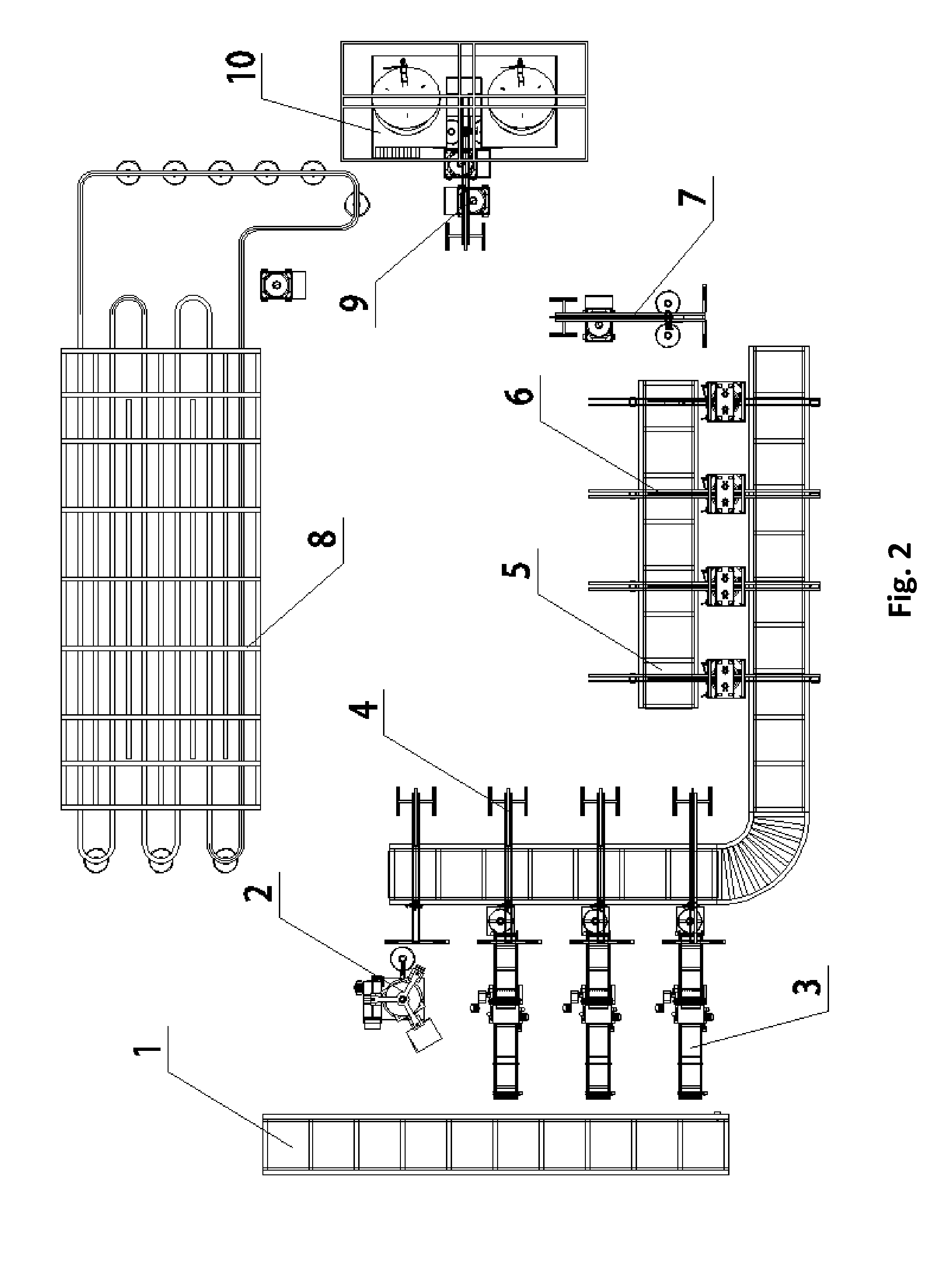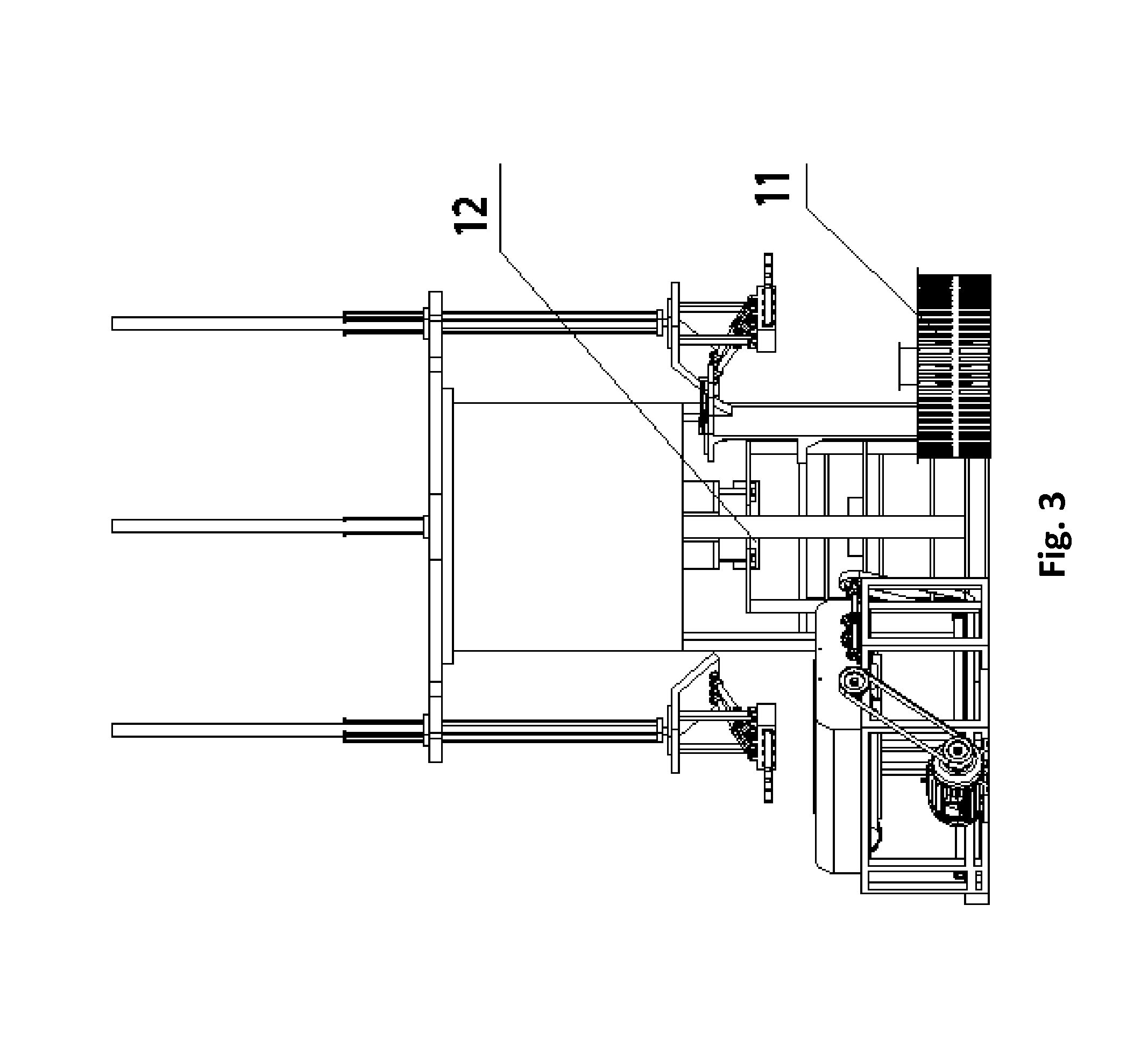Chain, continuous and no-waste method for degumming and fiber-separating the ramie
a fiber and ramie technology, applied in the field of ramie, can solve the problems of facing a severe problem, increasing environmental pollution, and exhausting global fossil resources, and achieve the effect of high consumption of chemicals and high consumption of water
- Summary
- Abstract
- Description
- Claims
- Application Information
AI Technical Summary
Benefits of technology
Problems solved by technology
Method used
Image
Examples
example 1
[0053]The degumming processing was performed using the process flow shown in FIG. 1 and the apparatus shown in FIGS. 2 and 3. The manually peeled ramie marketed in Xianning City, Hubei Province was purchased. 500 kg of the manually peeled ramie was placed into the waste alkali bath pool in a bath ratio of 1:20 (weight volume ratio) and immersed for 8 h. The solution in the pool was the alkaline wastewater discharged from the alkali-hydrogen peroxide one bath scouring-bleaching. Then, the degumming wastewater was precipitated by separate treatment, after which the resulted sludge was burnt directly and the supernatant was discharged into the sewage treatment unit.
[0054]The degumming wastewater was pumped into the sewage treatment unit, followed by the sewage treatment in the conditioning pool, the anaerobic pool, the first precipitation pool, the aerobic pool, the second precipitation pool etc.
[0055]The manually peeled ramie treated in the waste alkali bath was placed into the anaero...
example 2
[0060]The degumming processing was performed using the process flow shown in FIG. 1 and the apparatus shown in FIGS. 2 and 3. The manually peeled ramie marketed in Xianning City, Hubei Province was purchased. 500 kg of the manually peeled ramie was placed into the waste alkali bath pool in a bath ratio of 1:17 (weight volume ratio) and immersed for 8 h. The solution in the pool was the alkaline wastewater discharged from the alkali-hydrogen peroxide one bath scouring-bleaching. Then, the degumming wastewater was precipitated by separate treatment, after which the resulted sludge was burnt directly and the supernatant was discharged into the sewage treatment unit.
[0061]The degumming wastewater was pumped into the sewage treatment unit, followed by the sewage treatment in the conditioning pool, the anaerobic pool, the first precipitation pool, the aerobic pool, the second precipitation pool etc.
[0062]The manually peeled ramie treated in the waste alkali bath was placed into the anaero...
example 3
[0067]The degumming processing was performed using the process flow shown in FIG. 1 and the apparatus shown in FIGS. 2 and 3. The manually peeled ramie marketed in Xianning City, Hubei Province was purchased. 500 kg of the manually peeled ramie was placed into the waste alkali bath pool in a bath ratio of 1:22 (weight volume ratio) and immersed for 8 h. The solution in the pool was the alkaline wastewater discharged from the alkali-hydrogen peroxide one bath scouring-bleaching. Then, the degumming wastewater was precipitated by separate treatment, after which the resulted sludge was burnt directly and the supernatant was discharged into the sewage treatment unit.
[0068]The degumming wastewater was pumped into the sewage treatment unit, followed by the sewage treatment in the conditioning pool, the anaerobic pool, the first precipitation pool, the aerobic pool, the second precipitation pool etc.
[0069]The manually peeled ramie treated in the waste alkali bath was placed into the anaero...
PUM
| Property | Measurement | Unit |
|---|---|---|
| temperature | aaaaa | aaaaa |
| time | aaaaa | aaaaa |
| temperature | aaaaa | aaaaa |
Abstract
Description
Claims
Application Information
 Login to View More
Login to View More - R&D
- Intellectual Property
- Life Sciences
- Materials
- Tech Scout
- Unparalleled Data Quality
- Higher Quality Content
- 60% Fewer Hallucinations
Browse by: Latest US Patents, China's latest patents, Technical Efficacy Thesaurus, Application Domain, Technology Topic, Popular Technical Reports.
© 2025 PatSnap. All rights reserved.Legal|Privacy policy|Modern Slavery Act Transparency Statement|Sitemap|About US| Contact US: help@patsnap.com



